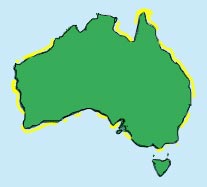Seagrasses of Australia
Distibution and Diversity
Distribution
Australia has approximately 51,000 km2 of seagrass meadows in shallow subtidal and intertidal environments. They are generally found in estuaries and sheltered bays where ocean currents and wave action are not as great.
| State |
Major areas of Seagrass |
Number of Species |
| New South Wales |
Jervis Bay, Botany Bay and Lake Macquarie |
8 species |
| Queensland |
Hervey Bay, Moreton Bay, Torres Strait |
15 species
It is estimated that there are nearly 6,000km2 of seagrass in Queensland waters shallower than 15 metres, and that up to 40,000km2 of the waters deeper than 15 metres of the Great Barrier Reef lagoon are likely to have some seagrass. |
| South Australia |
Spencer Gulf, Gulf of St Vincent and Encounter Bay |
22 species
covering an area of almost 10,000 kmcovering an area of almost 10,000 km2. |
| Tasmania |
Norfolk Bay and Pittwater |
5 species
Tasmania has about 1.0% of Australia’s seagrasses or about 50 km2 |
| Victoria |
Corner Inlet, Port Phillip Bay and Westernport Bay |
6 species |
| Western Australia |
Jurien, Marmion Marine Park, Shoalwater Islands Marine Park, Shark Bay, Cockburn Sound, Geographe Bay and Oyster Harbour. |
27 species
Western Australia has one of the biggest seagrass populations in the world. Seagrasses are estimated to cover some 20,000 km² of shallow seabed, and there are 27 species in this region. The variety of habitats along its western and southern coasts is often soft sands in shallow subtropical waters, ideal for these plants. |
| Northern Territory |
Gulf of Carpentaria, particularly off West Island in the Limmen Bight |
10 species |
|



|
| |
|
Next: Ecology ... |
|